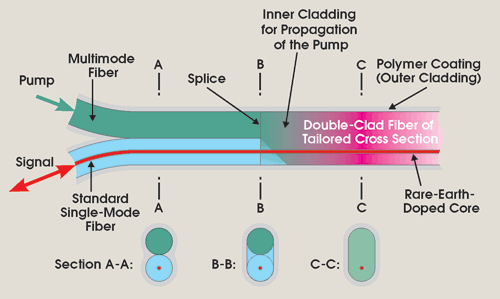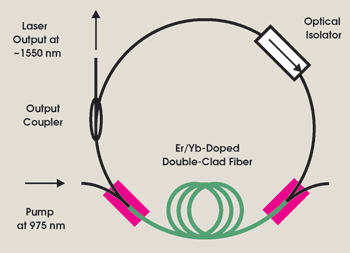Unusual approach may lead to rugged, compact fiber amplifiers.
Breck Hitz
A collaboration among Czech scientists has developed an approach to the end pumping of fiber amplifiers that, despite its need for an unusual fiber geometry, may significantly enhance the ruggedness and cost-effectiveness of the amplifiers in applications from telecommunications to materials processing.
Fiber lasers and amplifiers have proved to be remarkably efficient at converting the high-power, low-brightness output of diode lasers into high-power, high-brightness laser beams. In fact, fiber lasers are replacing older, conventional solid-state lasers in many medium- and high-power applications.
A big part of the reason for their success is the double-clad concept: The fiber is fabricated with a core surrounded by two concentric claddings. The signal light is guided in the low-numerical-aperture core and emerges in a low-divergence beam. The highly divergent pump light, on the other hand, is easily coupled into — and guided in — the high-numerical-aperture inner cladding. As the pump light travels along the inner cladding, it repeatedly crosses through the rare-earth-doped core, where it is absorbed to create a population inversion.
A problem with this technique is that it is difficult to couple both the signal and the pump into the same end of a double-clad fiber. In a simple Fabry-Perot fiber laser, it is easy enough to pump one end of the fiber and take the laser output from the other end. The difficulty arises, for example, when it is desirable to boost efficiency by pumping both ends of the fiber — or, in a fiber amplifier, when the low-amplitude signal enters one end of the fiber and emerges from the other.
There has been no shortage of techniques to alleviate this dilemma, but all are relatively complex, fragile and/or expensive. That is where the Czech scientists believe their approach may be superior to others.
The investigators — representing the Academy of Sciences of the Czech Republic and the Czech Technical University, both in Prague, fabri-cated an unusually shaped double-clad fiber so that both a single-mode fiber carrying the signal and a multimode fiber carrying the pump light could be spliced to it with a conventional, commercial fusion splicer (Figure 1). They measured the splice loss for the pump light at only 0.1 dB but saw a higher, 1.2-dB splice loss for the signal because of mode mismatch between the incoming single-mode fiber and the double-clad fiber. They believe that the signal loss could be significantly reduced by optimizing the core profile of the double-clad fiber.

Figure 1. The unusual geometry of the investigators’ double-clad fiber (on the right side of the figure, cross section C-C) consists of a small core offset from the center of an oval inner cladding. As shown on the left side of the figure, both a multimode fiber carrying the pump light and a single-mode fiber carrying the signal light are fusion-spliced to the double-clad fiber. Images reprinted with permission of Optics Letters.
The researchers fabricated their unusual double-clad fiber by side-polishing two conventional fiber preforms, one that had a core and one that did not, and pressing them together to produce a single preform from which they drew their fiber (Figure 2).

Figure 2. To fabricate their unusual double-clad fiber, the scientists made a single preform by fusing together two side-polished, conventional fiber preforms (left). The microphotograph shows the resulting fiber where the polymer outer cladding has been removed (right).
They first tested the laser efficiency of the double-clad fiber without splicing any fiber to it, merely by using bulk optics to focus pump light into one end of a Fabry-Perot laser. The Fresnel reflection from the cleaved facets provided resonator feedback, and the scientists observed a maximum slope efficiency (relative to absorbed pump power) of 26 percent from a 5-m length of fiber when they measured the laser output from both ends of the fiber.

Figure 3. The scientists tested their novel end-pumping scheme by configuring their laser as an all-fiber ring resonator. A multimode fiber and a single-mode fiber were coupled to the double-clad fiber at the locations shown as colored rectangles.
To evaluate the efficacy of their novel end-pumping scheme, they did not simply replace the bulk-optical coupling method in their Fabry-Perot experiment with the new scheme. Instead, they chose to reconfigure the laser as a ring with a similar output coupling ratio as in the Fabry-Perot laser (Figure 3). They pumped the ring with the same diode laser that they had used to pump the Fabry-Perot laser and observed a comparable (but slightly lower) slope efficiency.
They attribute the lower efficiency to transverse-mode filtering in the ring laser. In the simple Fabry-Perot laser, several transverse modes could propagate in the double-clad fiber but were filtered out by the single-mode fiber in the ring resonator.
Optics Letters, Nov. 15, 2006. pp. 3240-3242.